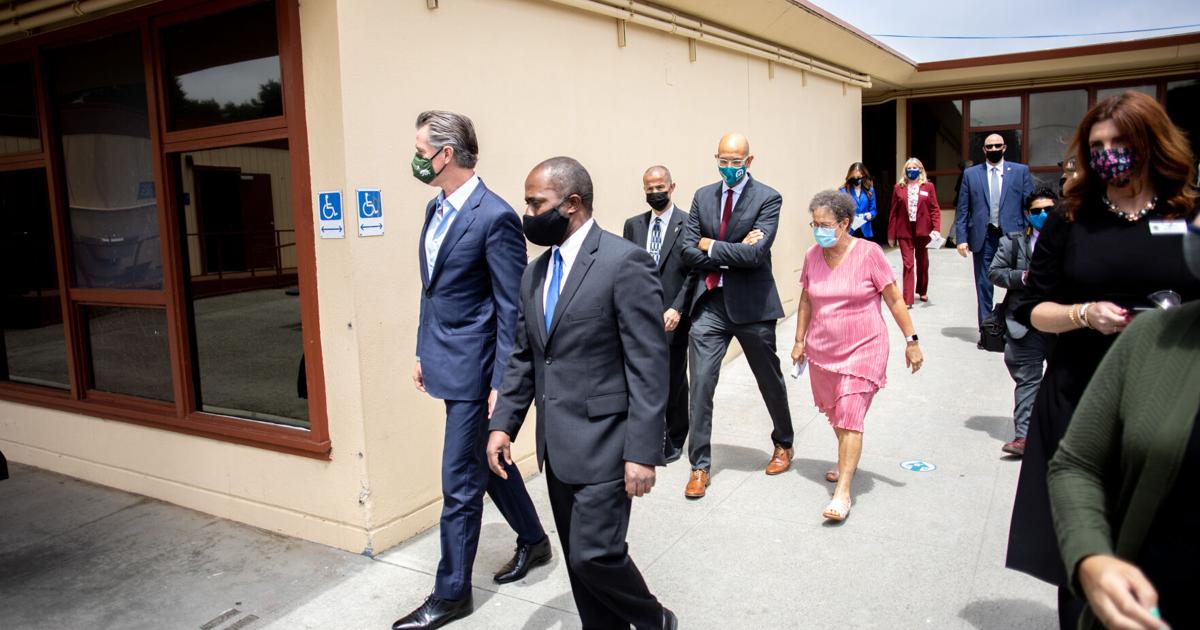
On Wednesday, May 12, Governor Gavin Newsom announced a $20 billion proposal to bolster the education system in California, speaking at Elkhorn Elementary School in Castroville.
The funds will come from a surplus of nearly $76 billion; Newsom said the state was “coming back” from the Covid-19 pandemic. Linda Darling-Hammond, president of the State Board of Education, said the reform could move California forward and “reinvent the public education system.”
This ambitious proposal includes the following elements:
Create another school year and make transitional kindergarten, TK, accessible to all. Currently, TK is only offered to students who turn 5 between September 2 and December 2. TK would be fully established by the 2024-2025 school year.
Nicole Wall, a fifth grade teacher at Elkhorn Elementary, says she sees a difference between students who have attended TK and those who have not. She says TK helps students learn school routines and gives them independence. She sees this as an advantage “especially in our community where we have a lot of English learners. It also immerses students in teaching English.
The Alisal Union School District launched a radio campaign on May 1 to boost enrollment in Tk and kindergarten, as enrollment in both declined, both in California as a whole and specifically at AUSD .
“School is not just about learning letters or numbers. The school also teaches children the importance of sharing, of taking turns, of becoming members of a larger community. Learning these skills at an early age gives children an edge in life,” said Susan Ratilff, Director of Early Learning at AUSD, in a press release.
Create service-oriented community schools. Newom’s proposal would provide $3 billion for wraparound services. Sandra Cuevas, principal of Elkhorn Elementary, says there are many needs among families who live in the North Monterey County Unified School District.
Cuevas says that during the pandemic, families have struggled to go or afford to wash and dry their clothes. To help struggling families, the district installed a washer and dryer. The district also has a Family Resource Center in Castroville with resources such as counselors, parenting classes, before and after school programs and more.
Funding for before and after school services and summer programs. A universal before and after school program would primarily focus on districts with a high number of English learners. It would start with $1 billion, and after that it would be funded at $5 billion a year.
Wall says providing summer programs will help bridge the gap between students from different financial backgrounds. “These services will help children who don’t have the opportunity to meet their community peers,” she says.
Wall also notes that during remote learning due to the pandemic, summer school programs were the only way for some NMUSD families to connect to the internet.
Create a pool of teachers and provide additional training resources. Newsom’s proposal calls for investing $3.3 billion in a teacher pipeline, designed to end the teacher shortage and also to ensure teachers are placed where they are needed most. The proposal would provide professional development and training opportunities. Darling-Hammond said that’s part of making California a leader in education once again.
According to the Learning Policy Institute, teacher shortages are severe in rural districts, especially in math and science. Districts across the country have also faced increasing numbers of furloughs, resignations and retirements due to the Covid-19 pandemic.
Strengthen student health and mental health services. Newsom is proposing $4 billion to provide access to health services, including mental health services, for people aged 0-25.
“Some young people aren’t getting the help they need in time,” Dr. Mark Ghaly, secretary of California Health and Human Services, said at the Elkhorn Elementary press conference. “We are moving from a reactionary system to a proactive system.”
Creation of a savings account for children in the public school system. It would be the first of its kind, with $500 accounts for students. Newsom’s proposal would invest $3.7 million in the project, intended to provide opportunities for low-income students. “If you believe in going to college, you have to create a college mindset,” he said. California could become the first state to create such a program.
Professor Willian Elliott of the University of Michigan conducted a study in 2013 that analyzed families with incomes below $50,000. Students in these families who had between $1 and $499 in a college savings account were at least four times more likely to attend college than those who did not have a college savings account.
Tony Thurmond, state superintendent of public instruction, said the $20 billion proposal would help fill gaps in the education system and support students inside and outside the classroom. .
Wall says that if these programs are implemented, the state should have a plan to make them permanent, given the underlying inequalities. “We really need these programs to stay,” she says. “Disadvantaged, low-income students aren’t going anywhere.”


